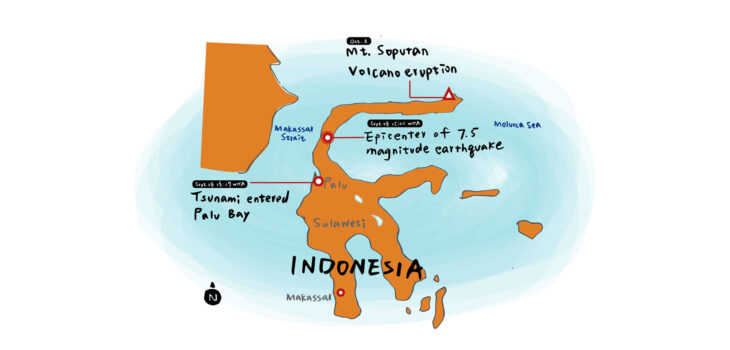
Tsunami & Sea Rising
Sept 28, 2018 The 7.5-magnitude quake, which struck in the early evening, was centered along the coast of the island of Sulawesi about 50 miles north of Palu. Shortly afterward — within 30 minutes by some accounts — waves as high as 18 feet crashed ashore in the city, destroying buildings, smashing vehicles and killing hundreds of people.
How tsunamis work
Tsunamis are just larger version of regular waves. They have a trough and a crest, and consist not of moving water, but the movement of energy through water. The difference is in where this energy comes from.
For normal ocean waves, it comes from wind. Because this only affects the surface, the waves are limited in size and speed. But tsunamis are caused by energy originating underwater, from a volcanic eruption, a submarine landslide, or most commonly, an earthquake on the ocean floor.
An earthquake on the ocean floor caused when the tectonic plates of the Earth’s surface slip, releasing a massive amount of energy into the water. This energy travels up to the surface, displacing water and raising it above the normal sea level, but gravity pulls it back down, which makes the energy ripple outwards horizontally. Thus, the tsunami is born, moving at over 500 miles per hour.
When it’s far from shore, a tsunami can be barely detectable, since it moves through the entire depth of the water. But it reaches shallow water, something called wave shoaling occurs. Because there is less water to move through, this still massive amount of energy is compressed. The wave’s speed slows down, while its height rises to as much as 100 feet(30.48m).
If the trough of a tsunami reaches shore first, the water will withdraw farther than normal before the wave hits, which can be misleadingly dangerous. A tsunami will not only drown people near the coast, but level buildings and tress for a mile inland or more, especially in low-lying areas. As if that weren’t enough, the water then retreats, dragging with it the newly created debris, and anything or anyone, unfortunate enough to be caught in its path.
Even minor sea-level rise, by as much as a foot, poses greater risks of tsunamis for coastal communities worldwide.
The threat of rising sea levels to coastal cities and communities throughout the world is well known, but new findings show the likely increase of flooding farther inland from tsunamis following earthquakes. Think of the tsunami that devasted a portion of northern Japan after the 2011 Tohoku-Oki earthquake, causing a nuclear plant to melt down and spread radioactive contamination.
*The sea-level rise dramatically increased the frequency of tsunami-induced flooding by 1.2 to 2.4 times for the 1.5-foot increase and from 1.5 to 4.7 times for the 3-foot increase. Mr.Li, a senior researcher at Virginia Tech, said, “We found that the increased inundation frequency was contributed by earthquakes of smaller magnitudes, which posed no threat at current sea level, but could cause significant inundation at higher sea-level conditions.”
| Reference | The New York Times USA today / How tsunamis work